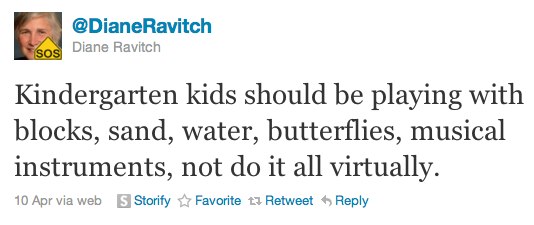I like Maine a lot. It's a beautiful place -- oh my, the blueberries! -- and my little brother and his family live there. But that's not the only thing that makes me biased in favor of the state.
Maine has been at the forefront of one-to-one computing initiatives, dating all the way back to 2002 when the state launched a program putting laptops in the hands of all seventh and eighth graders. That's almost ten years of thinking about the impact of one-to-one technology -- how it changes (and whether it changes) teaching and learning.
So I admit, I was a little surprised this week when the news that a school district in Maine is investing in iPads for their kindergarteners was viewed with such shock and outrage. I first heard the news a couple of weeks ago from my friend Mike Muir, who's just started working in the Auburn School District. Interesting, I thought -- let's see how this is different from other one-to-one initiatives in the state. Let's see how iPads are different from laptops. Let's see how kindergarteners (and their teachers) use the devices differently than other age groups do.
Perhaps it was a titillating quotation from the district superintendent Tom Morrill that an iPad is "even more important than a book" that set folks off. Perhaps it was the large expenditure -- $200,000 -- in a time when many schools are facing budget crises. I'm not sure. But there were a lot of stories that frowned on the project, and I found myself engaging in a Twitter spat over the issue with Diane Ravitch who set up what I perceived as a false dichotomy: kids get either play or technology. Kids get either books and crayons or iPads.

Now, I do think that we need to do much more than pass out iPads and assume that because we've equipped students with a technology tool that we've magically "changed the game." I think the decade-long experiment with laptops in Maine classrooms has demonstrated that. Why, test-scores in the state haven't risen! So clearly it's a waste of money! (That's sarcasm, folks, just so we're clear.) One-to-one computing, when done well, does require a shift in instruction, moving away from the teacher-at-the-front-of-the-classroom dynamic. It isn't simply about implementing a new technology; it's about rethinking the classroom. That's something to praise, not panic over.
But lest you need something to make your toes curl, to make you fearful of the future of small children and iPads, let me tell you this: Random House has just released the childhood favorite Pat the Bunny as an iPad app. Think of how we're skewing children's experience with touching and feeling! Clearly it's time to freak out now, don't you think?